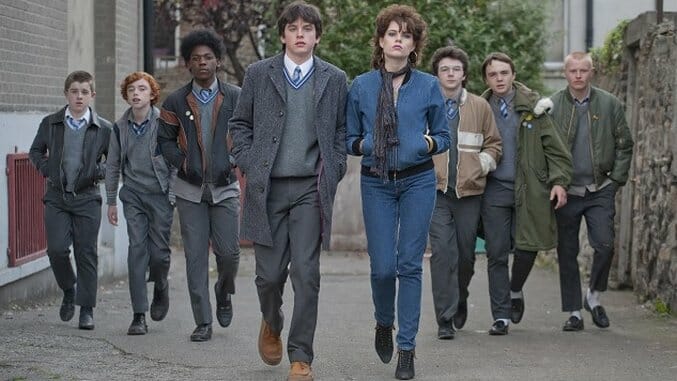Sing Street

People put all kinds of sentimental bric-a-brac in their time capsules: ticket stubs, blueprints to their homes, the bouquet from their wedding, selections of poetry, newspaper clippings from a specific date, records, trading cards, birth certificates, photographs. They may write letters to whom it may concern on the day the capsule is meant to be uncorked, perhaps their children or their children’s children, perhaps their siblings. For filmmaker, writer and erstwhile musician John Carney, the movies are time capsules, and Carney loads his movies with distillations of himself, with Dublin, and in his latest, Sing Street, with memories of the 1980s. This isn’t a nostalgic movie, though. It’s a movie that peers through nostalgia like harsh light through a sheer curtain.
Sing Street spins art out of history, but you might mistake it for pop sensationalism at first glance. If so, you’re forgiven. In sharp contrast to Carney’s breakout movie, 2007’s sterling adult musical Once, or even his most recent effort, 2013’s Begin Again, Sing Street aims to please crowds and overburden tear ducts. There’s a sugary surface buoyancy to the film that helps the darkness clouding beneath its exterior go down more easily. Here, look at the plot synopsis: A teenage boy living in Dublin’s inner city in 1985 moves to a new school, falls in love with a girl, and forms a band for the sole purpose of winning her over. If the period Carney uses as his storytelling backdrop doesn’t make Sing Street an ’80s movie, then the mechanics of its story certainly do. You may walk into the film expecting to be delighted and amused. The film won’t let you down in either regard, but it’ll rob you of your breath, too.
The boy is Conor (Ferdia Walsh-Peelo). The girl is Raphina (Lucy Boynton). Conor is the youngest child of three, including his older brother Brendan (Jack Reynor), in a family whose patriarch and matriarch (Aidan Gillen, Maria Doyle Kennedy) have fallen on hard times in life and with each other. Raphina is aloof, a model in training with designs on getting the hell out of Dublin and hightailing it to London, just as two-hundred-some-odd-thousand of young Irish folks did throughout the decade. This is a recurring theme of Carney’s work: exodus, specifically from Ireland, a place his cinema views through multifaceted lenses. Sometimes Carney’s Ireland looks beautiful, even magical. Other times it looks downturned and hopelessly backward, a set of iron socioeconomic jaws that chew its citizens up and spit them back out.
-

-

-

-

-

-

-

-

-

-

-

-

-

-

-

-

-

-

-

-

-

-

-

-

-

-

-

-

-

-

-

-

-

-

-

-

-

-

-

-








































